Netflix creators pulled a popular high school novel off the dusty bookshelves and onto screens nationwide.
In “13 Reasons Why,” the plot transitions smoothly between the present tense and flashbacks with Hannah. Clay conveniently had a huge gash on his forehead, from falling off his bike, making it easy to tell when a scene is present tense. Having the flashbacks allows viewers to form a connection with Hannah and see what her life was like when she was still alive.
The overall theme of the show is actions and words are more harmful than one may think. Hannah shows how little things all stack up and become an unbearable load. “13 Reasons Why” also showed everyone is dealing with struggles of their own, even if they do not show it.
During Hannah’s lifetime, many of her peers spread rumors about her, which damaged her reputation and ultimately her self-esteem. Hannah created the tapes to show others what actually happened.
“The truth isn’t always the most exciting version of things…but it deserves to be heard and remembered,” Hannah said.
The show did not stick to the book’s original period, but rather revealed it in modern day. Thus many of the high schoolers had smart phones and iPads even though those gadgets did not exist in early 2000s. While I understand, they wanted to make “13 Reasons Why” relatable to today’s audience, it bothered me that they polarized it with Hannah’s cassette tapes.
Overall, both the book and show did a good job covering an often avoided topic — suicide.



The Slate welcomes thoughtful discussion on all of our stories, but please keep comments civil and on-topic. Read our full guidelines here.